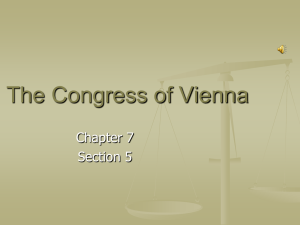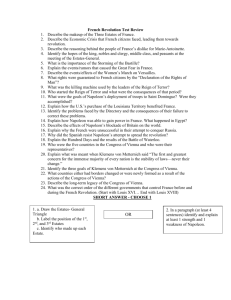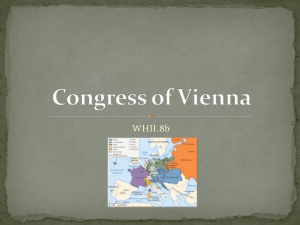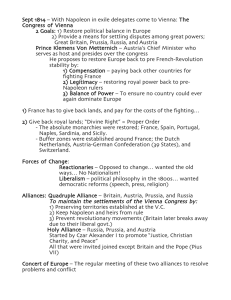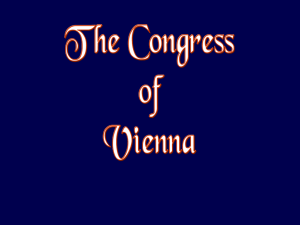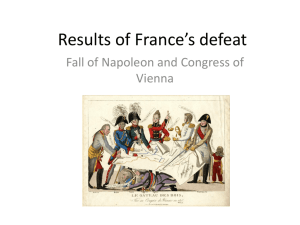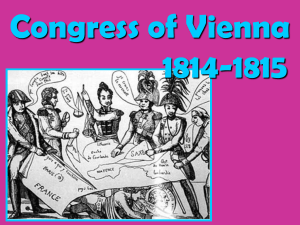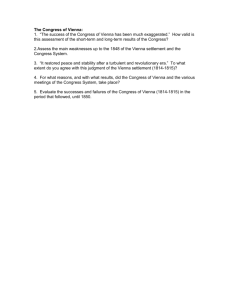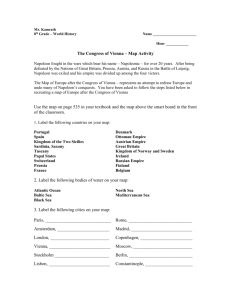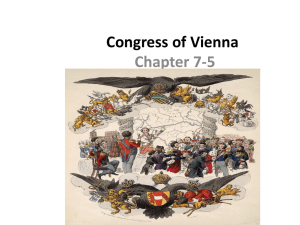Congress of Vienna
advertisement
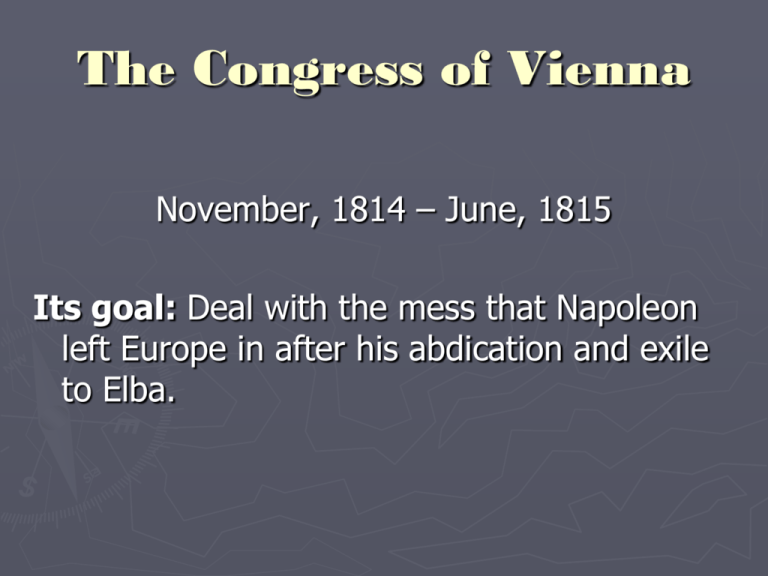
The Congress of Vienna November, 1814 – June, 1815 Its goal: Deal with the mess that Napoleon left Europe in after his abdication and exile to Elba. I. Europe After Napoleon Congress of Vienna (1814-1815) • Almost every state in Europe sent a representative. • Leading political figures from the four powers gathered in Vienna to decide the fate of Europe. - Austria – Clemens von Metternich Russia – Czar Alexander I Great Britain – Lord Robert Castelreagh Prussia – Prince Karl Hardenburg The Four Leaders Clemens von Metternich Lord Robert Castelreagh Czar Alexander I Prince Karl Hardenburg The Congress of Vienna convenes under the leadership of Metternich Europe After Napoleon Congress of Vienna (1814-1815) • Most of Europe’s leaders hoped to nullify revolutionary and Napoleonic reforms and restore the old order (pre-1789). - Under the principle of “Legitimacy” they hoped to restore the original rulers to the thrones of countries that Napoleon conquered or created. - Under the principle of “Compensation” the map of Europe was redrawn to compensate countries for their losses to Napoleon and/or to reward them for their contributions to the defeat of Napoleon. Changes to the map instituted by the Congress of Vienna Europe 1812 Europe 1815 Changes to the map instituted by the Congress of Vienna ► EXAMPLES: ► Russia received most of the former Grand Duchy of Warsaw, Finland (from Sweden) and Bessarabia (from the Ottoman Empire) ► Prussia received two-fifths of Saxony, Westphalia and Swedish Pomerania from the HRE; they also received the Rhine River provinces from France Changes to the map instituted by the Congress of Vienna (cont.) ► Austria received Lombardy, Venetia, Illyria, Dalmatia and Galicia ► Britain received overseas colonies such as Cape Colony, Ceylon, Mauritius, Malta, the Ionian Islands and Heligoland (two islands of the coast of Germany) ► Switzerland neutral became independent and Changes to the map instituted by the Congress of Vienna (cont.) ► The German Confederation replaced the HRE. It consisted of 39 states rather than 300+ states of the HRE ► The Italian Peninsula was divided into various kingdoms ► The Kingdom of the Netherlands (Holland) gained Belgium, as a defense against France Europe After Napoleon • France’s representative, Charles Talleyrand was able to convince the Congress that France should remain a strong, respected country. • The guiding principle of international relations at the Congress of Vienna was “Balance of Power”. Its purpose was to establish a lasting peace in Europe. • Originally, the four powers established a “Quadruple Alliance” whose purpose was to prevent war in Europe. Later, France was added to establish the “Quintuple Alliance”. • Russian Czar Alexander I proposed a “Holy Alliance” of Christian nations against revolutionary upheavals anywhere in Europe. - Austria & Prussia agreed, Britain didn’t. - Britain wanted to reserve the right to act according to its interests, not anyone else’s. • The decisions made at Vienna ensured peace in Europe until 1850 and no major wars until World War I (1914). Hard Work and Play The Congress of Vienna was noted for its lavish parties, great feasts, romances, and consumption of alcohol – all in the name of Diplomacy.
